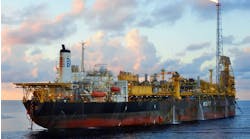Subsea tiebacks are playing a major role in the offshore industry’s recovery from the oil price crash and COVID-19 pandemic. The low capex requirements and short cycle times have enabled many projects to move forward. While Norway is expected to be the global leader for subsea tiebacks over the next few years, several projects are progressing in the deepwater Gulf of Mexico and Brazil.
Norway
Temporary tax incentives introduced by the Norwegian government in mid-2020 have spurred a wave of new subsea tiebacks offshore Norway.
Aker BP and partners Equinor and Spirit Energy have sanctioned development of the Hanz oil and gas field in the Norwegian North Sea. Located in license 028 B, Hanz will be tied into the Ivar Aasen platform about 12 km (7.5 mi) to the south. Total investments are estimated at NOK 3.3 billion ($364 million). Start-up is expected in the first half of 2024. Total reserves are about 20 MMboe. Subsea 7 received an engineering, procurement, construction, and installation (EPCI) contract for the gas lift pipelines, the pipe-in-pipe production lines, and associated subsea infrastructure.
Aker BP and partners ConocoPhillips and Lundin Energy have submitted a plan for development and operation (PDO) for the Kobra East and Gekko (KEG) project in the northern Norwegian North Sea. The development, designed to recover around 40 MMboe, will help extend the lifetime of the host FPSO Alvheim through 2040. Operator Aker BP estimates total investments in the 8-km (5-mi) subsea tieback at about $1 billion and a breakeven cost of less than $30/bbl. Start-up is targeted for 1Q 2024.
Aker Solutions will deliver the subsea production system that will include four horizontal subsea trees, three manifolds, control systems, three static umbilicals, and associated tie-in equipment and installation work. Subsea 7 is responsible for engineering of the subsea tieback, which will connect to the Kneler B subsea manifold. Its EPCI scope covers the pipelines, spools, protection cover and tie-ins. The production pipeline will be a pipe-in-pipe design.
Aker BP and partners Vår Energi AS and Lundin Energy Norway AS have submitted a PDO for the Frosk field, which is about 25 km (16 mi) southwest of the FPSO Alvheim. It will be tied back to the FPSO via the existing Bøyla subsea infrastructure. Two new production wells will be drilled. Total investments are estimated at NOK 2 billion ($230 million). Production is scheduled to start in 1Q 2023. Recoverable reserves are estimated at around 10 MMboe.
The company has engaged the Semi Alliance (Aker BP, Odfjell Drilling, and Halliburton) for drilling and completions of the new wells and the Subsea Alliance (Aker BP, Subsea 7, and Aker Solutions) to execute the subsea facilities scope.
Meanwhile, OKEA has approved its first operated field development offshore Norway. The company and partners Petoro and Neptune Energy plan to tieback the Hasselmus gas discovery to the Draugen production platform in the Norwegian Sea via one subsea well. This will be the first tieback to the facility. Hasselmus should produce 10.6 MMboe as fuel and export gas, also allowing exports to resume of associated gas including NGL, currently injected into the Draugen reservoir. OKEA estimates project costs at NOK2.4 billion ($290 million). Start-up is targeted for 4Q 2023.
The Subsea Integration Alliance of Subsea 7 and OneSubsea is responsible for the subsea production systems and pipelines. The scope covers around 9 km (5.6 mi) of pipe-in-pipe flowlines and associated structures in water depths of around 250 m (820 ft).
In addition, Equinor and partners Petoro, Vår Energi, and TotalEnergies have committed to Phase 1 of the Kristin South project in the Norwegian Sea. This involves developing the Lavrans and Kristin Q discoveries via tiebacks to the Kristin semisubmersible production platform. Equinor estimates capex for Phase 1 at around NOK6.5 billion ($760 million).
A new subsea template will be installed at Lavrans, while Kristin Q will be tied into an existing template. Equinor plans four wells at Lavrans and one at Kristin Q. The Kristin field started gas/condensate production in 2005. While the platform is technically designed to operate until 2034, its service could be extended through 2042.
Lavrans, discovered in 1995, contains large gas volumes, although the reservoir is complex reservoir and the production characteristics uncertain. The wells will address the uncertainty by featuring long horizontal production zones in the reservoir. Kristin Q is in the southern part of the Kristin field and is a high-pressure/high-temperature reservoir. The two accumulations will head through a common pipeline to the platform.
Equinor expects Phase 1 to deliver a total of 58.2 MMboe. The first two wells at Lavrans and one at Kristin Q is scheduled to start up in 2024, followed by the other two wells at Lavrans in 2025. Aker Solutions will supply the subsea production facilities. TechnipFMC will deliver rigid pipelines, static and dynamic umbilicals, as well as pipeline and install the subsea production facilities.
Finally, ConocoPhillips Skandinavia AS has submitted the PDO for the Tommeliten A field in the North Sea to the Norwegian Ministry of Petroleum and Energy and the UK’s Oil and Gas Authority.
Tommeliten A is a UK-Norway trans-boundary field as it extends from Norwegian block 1/9 into UK block 30/20. The development concept is a two-by-six slot subsea production system with 10 production wells and an electrically heated flowline, tied into the Ekofisk complex, including installation of a new processing module. The field is about 25 km (16 mi) southwest of the Ekofisk complex. Resource potential for the Tommeliten A field is estimated to be in the range of 80-180 MMboe, mainly comprising gas condensate. Total investments are estimated at NOK 13 billion ($1.5 billion). First production is expected in 2024. Aker Solutions will provide the subsea production system including 10 vertical subsea trees, two manifolds, wellheads, satellite structures, control systems, and tie-in equipment.
Other partners are PGNiG Upstream Norway AS, TotalEnergies EP Norge AS, Vår Energi AS, ConocoPhillips (U.K.) Holdings Ltd., TotalEnergies UK Ltd., and ENI UK Ltd.
Gulf of Mexico
BHP and Chevron are progressing separate subsea tieback projects in the deepwater Gulf of Mexico.
BHP and partner Repsol have committed to Shenzi North, a two-well subsea tieback to the Shenzi TLP on Green Canyon block 653. Production is expected to start in 2024. Trendsetter Engineering Inc. will provide subsea manifolds, high integrity pressure protection systems (HIPPS), and multiple subsea connection and jumper systems leveraging its TCS connector technology. Trendsetter has partnered with Proserv for the HIPPS control system and ATV for the HIPPS shutdown valves.
Meanwhile, Chevron is progressing the Ballymore development, the first Norphlet asset in the GoM. The selected development concept expands the production capacity of the Blind Faith floating production unit and uses the available riser and umbilical slots. Ballymore will tieback through a subsea production system designed to accommodate the high pressures and temperatures and unique fluid properties associated with the Norphlet trend. The Ballymore oil and gas field is in Mississippi Canyon block 607 in a water depth of 2,006 m (6,581 ft). Worley is providing brownfield modification services for the tieback. The company is supporting both the subsea and topsides designs and will also provide procurement services for topsides.
Brazil
Karoon Energy and PetroRio are advancing subsea tiebacks offshore Brazil.
Karoon Energy has committed to develop the Patola field in the Santos basin. Patola, in 300 m (984 ft) of water in license BM-S-40, is adjacent to the producing Baúna and Piracaba accumulations. Two near-vertical subsea production wells will be tied back to spare riser slots on the FPSO Cidade de Itajaí at the Baúna field.
TechnipFMC will design, manufacture, and install the x-mas trees, flowlines, risers, umbilical, and controls under an integrated EPCI contract, scheduled for completion during 2H 2022.
Karoon estimates the cost of the development at $175-195 million. Patola, due to come onstream early in 2023, should initially produce more than 10,000 b/d from reservoirs of the same geological age as those in Baúna and Piracaba. The development will target 14.7 MMbbl of 2C resources, comprising 13.2 MMbbl in Patola and an additional 1.5 MMbbl in Baúna arising from injecting Patola’s gas into the Baúna reservoir.
Also, PetroRio has filed a declaration of commerciality and development plan for the Wahoo oil field in the C-M-101 block in the presalt Campos basin with Brazil’s National Petroleum Agency. Wahoo, in 1,400 m (4,593 ft) of water, is thought to hold 126 MMbbl recoverable within a carbonate reservoir.
The company plans a tieback of up to 35 km (21.7 mi) south to the Frade field FPSO, with the associated gas used for power generation on the platform.




